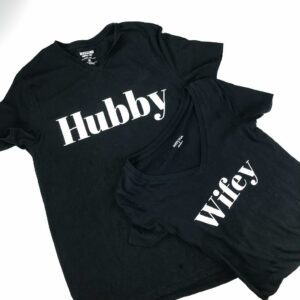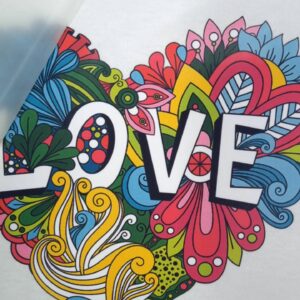Are you trying to find the ideal method for personalizing your clothing, luggage, or headwear using beautiful designs?
Look nowhere else!
Two well-liked techniques stand out in the realm of customized clothes decoration: DTF Printing and Heat Transfer Vinyl. We can produce & apply complex patterns to a variety of materials using both DTF printing and heat transfer vinyl. These approaches, however, vary in terms of price, robustness, and quality.
You’re in luck if you’re trying to decide which approach is best for your professional or personal endeavor. To help you make an educated choice and get the best results, we’ve broken down this article- DTF Printing vs Heat Transfer Vinyl in our in-depth comparison guide. So let’s get started and find out which approach best suits you and your design requirements.

Difference Between HTV vs DTF Printing
| Comparison Factors | DTF Printing | Heat Transfer Vinyl |
|---|---|---|
| Fabric Compatibility | Wide range | Cotton and polyester |
| Level of Detail | Fine details | Precise designs |
| Color Options | Wider range | Limited to pre-colored vinyl sheets |
| Cost | More expensive | More affordable |
| Durability | Long-lasting | Durable, but may peel or crack over time |
| Production Volume | Ideal for larger volumes | Ideal for small batch production or one-off designs |
DTF Printing

DTF Printing is a relatively recent technique for decorating clothing that entails printing a pattern onto a certain kind of film. A heat press is then used to transfer the pattern from the film to the clothing.
Benefits:
- Vibrant hues.
- Capability of printing tiny print and fine details on a variety of textiles, including cotton, polyester, and mixes.
- Ideal for comfy apparel, soft and flexible feeling.
Drawbacks:
- Processing takes longer than with other techniques.
- Cost increase brought on by the need for specific materials and equipment.
- Maybe not as long-lasting as other techniques, and if not properly maintained, might peel or shatter over time.
Heat Transfer Vinyl

Heat Transfer Vinyl is a method of apparel decoration that involves cutting a design out of a special type of vinyl using a plotter or cutter. The design is then applied to the garment using a heat press.
Benefits:
- Resistant to fading, peeling, or cracking, vibrant and durable patterns.
- It is suitable for small batch manufacturing or one-off designs since it is fast and simple.
Drawbacks:
- Limitations on the type of fabrics that you can use (typically works best with cotton or polyester).
- Fewer color possibilities than with other techniques since drawings are cut from vinyl sheets that have already been colored.
- A few kinds of clothes or accessories may not be suitable for designs if they have a rigid feel.
DTF Printing vs Heat Transfer Vinyl Compared
Cost Comparison
DTF Printing is often more costly than Heat Transfer Vinyl in terms of price. This happens as a factor of the expensive and specialized materials and equipment needed for DTF Printing. Heat Transfer Vinyl, on the other hand, needs less equipment and is often more cheap.
Durability Comparison
DTF Printing is often less robust than Heat Transfer Vinyl in terms of durability. Heat Transfer Vinyl patterns may survive several washings without losing their vibrancy or integrity and are resistant to fading, peeling, and breaking. On the other side, DTF Printing could not be as resilient and might peel or break over time if it is not properly cared for.
Quality Comparison
Both can produce high-quality designs, but there are certain distinctions to take into account. DTF Printing is famous for creating vivid, intricate, soft, and flexible graphics that are perfect for casual apparel. Although Heat Transfer Vinyl may not have as many color possibilities, it may create graphics with sharper edges and a more “stiff” feel, which makes it perfect for certain kinds of apparel or accessories.
The precise requirements of the project, together with the budget and other criteria, will determine whether you should use DTF Printing or Heat Transfer Vinyl. When determining which technique to use, it’s vital to take into account the kind of cloth, the design, the amount of detail needed, and the intended outcome.
Heat Transfer Vinyl or DTF- Which one to Choose & Why?
There are various aspects to consider while deciding between DTF Printing and Heat Transfer Vinyl, including:
- Type of fabric: Heat Transfer Vinyl works best on cotton and polyester. DTF Printing is used on a broader variety of materials.
- Detail: Heat transfer vinyl works best for designs with accurate measurements and sharp edges while DTF printing is ideal for tiny text and fine details.
- Color Production: DTF Printing is able to generate a broader variety of colors, while Heat Transfer Vinyl can only manufacture pre-colored vinyl sheets.
- Budget: Due to the specific equipment and materials needed, DTF Printing is often more costly than Heat Transfer Vinyl.
Production volume: DTF Printing is preferable for higher numbers, whereas Heat Transfer Vinyl is great for small batches or one-off designs. - Required Detail Level: DTF Printing is preferred over HTV if your design calls for tiny text or delicate details.
- Fabric type: If you need to print on a variety of textiles, DTF Printing could be the best option.
- Color options: DTF Printing can be a better alternative if you need a broader variety of colors.
- Budget: Heat Transfer Vinyl is a good option if yours is tight.
- Production volume: If you need to manufacture a huge quantity of things, DTF Printing may be your best option.
You may choose the best technique for your project by taking these considerations into account.
Also See: DTF Printing vs Sublimation Printing
Is DTF Better than Vinyl (HTV)?
Vinyl and DTF printing both have specific advantages and disadvantages.
DTF printing can generate more fine details and tiny text and has a greater choice of color selections and fabric compatibility. Nevertheless, DTF printing is often more costly and, in certain circumstances, may not be as durable as vinyl.
On the other hand, vinyl is more cost-effective, robust, and capable of creating accurate patterns with sharp edges. The only pre-colored vinyl sheets that may be used, and it might not be compatible with all kinds of textiles.
DTF printing may be a better option if your project calls for finely detailed patterns on a variety of textiles. On the flip side, vinyl can be a more cost-effective and long-lasting solution if you need accurate patterns on cotton or polyester.
The decision between the two approaches ultimately comes down to the particular requirements of your project, including the kind of fabric, needed degree of detail, available colors, budget, and volume of production.
Does DTF Feel Like Vinyl?

No, the textures and feels of vinyl and DTF (Direct to Film) printing are different.
DTF printing includes printing ink onto a unique film, which is then heated and pressed to transfer the ink to the fabric. The fabric fibers and ink combine to create a silky, smooth surface that is comfortable to wear. DTF printing has a texture that is more akin to screen printing, where the pattern is incorporated into the fabric.
Contrarily, vinyl is a plastic substance that is cut into the required form and applied to the cloth under pressure and heat. Vinyl may feel less soft than DTF printing because of its somewhat raised, rubbery texture. Nevertheless, the kind of vinyl used and the thickness of the pattern might affect how the vinyl feels.
DTF printing hence typically has a softer and more pleasant feel than vinyl. Nonetheless, the vinyl’s texture may vary and may still be appropriate for some applications or designs.
Is Vinyl Better than Transfer Paper?
Both vinyl and transfer paper have certain advantages and disadvantages of their own.
Vinyl is a tough substance that you can cut into the necessary form and then heated and pressed onto the cloth. It comes in a variety of hues and finishes and is perfect for creating accurate patterns with clean edges. Moreover, vinyl is quite simple to work with and is good to create both little and huge patterns.
In contrast, transfer paper entails printing the pattern on unique paper, which is then applied under pressure and heat to the cloth. Transfer paper is the best material for creating intricate and high-quality graphics, including pictures and multicolored images. It may be applied to a greater variety of materials, including cotton, polyester, and mixes, and is more reasonably priced than vinyl.
So, vinyl can be a better option if your project calls for exact patterns with sharp edges or a certain color or finish. But, transfer paper can be the most cost-effective and adaptable choice if you need finely detailed graphics on a larger variety of textiles, including cotton and polyester.
In the end, the decision between vinyl and transfer paper comes down to the particular requirements of your project, including the kind of cloth, amount of detail needed, color choices, budget, and production volume.
Conclusion | HTV vs DTF Printing
The distinctions between DTF Printing and Heat Transfer Vinyl have been covered in this blog post. We have examined each method’s advantages and disadvantages, and compared their costs, dependability, and quality. We have also included ideas and criteria to help you choose the best approach for your project.
Customizing garments and accessories is successful with both DTF printing and heat transfer vinyl. The exact requirements of your project, such as the kind of fabric, needed degree of detail, available colors, budget, and production volume, ultimately determine which of the two you should choose.
DTF Printing can be the preferable option if you want finely detailed graphics on a larger variety of materials, despite the greater cost. On the other hand, Heat Transfer Vinyl can be the most cost-effective and long-lasting choice if you need accurate patterns on cotton or polyester.
Whatever approach you choose with, it’s critical to deal with a trustworthy and knowledgeable printing business to ensure that they create your ideas to the greatest standard. You may design unique apparel and accessories that stand out and make a statement by using the correct technique and partner.
FAQs
Absolutely, because of the price of the specialist DTF printer and the film used in the printing process, DTF printing is often more costly than heat transfer vinyl.
Definitely, due to the capacity for fine details and tiny text, DTF printing may result in graphics that are more detailed than heat transfer vinyl. The precise design and the chosen fabric, nevertheless, also influence the amount of intricacy.
DTF printing, which can print full-color graphics, is often preferable for creating designs with a variety of hues. The range of color selections for heat transfer vinyl is restricted to pre-colored vinyl sheets.
Since vinyl is thicker and can endure several washings without fading or splitting, it is often more durable than DTF printing. Nevertheless, the particular vinyl or DTF film used also affects how long anything lasts.
Cotton, polyester, and mixes are just a few of the many textiles that may be printed on using DTF technology. In materials with a loose weave or significant stretch, it may not perform as effectively.
Absolutely, you may use heat transfer vinyl for both tiny and big patterns. Larger patterns, on the other hand, may need many sheets of vinyl and precise alignment during the transfer process.
DTF printing is more environmentally friendly than other printing technologies since it does not utilize chemicals or water. The film used in the printing process, on the other hand, is not biodegradable and may add to trash.
Yes, you can layer heat transfer vinyl to make graphics with several colors. This may need precise alignment and numerous transfers, which might increase manufacturing time and expense.
Since the ink fuses with the fibers of the fabric, DTF printing is better for making designs with a soft feel. Heat transfer vinyl has a rubbery texture and a slightly raised look. It may be less soft than DTF printing.

Ashley Wang is a skilled sales manager with knowledge in DTF printing. She presently works for ShenLan Digital, a reputable DTF printer maker. Ashley is the best person to offer advice on selecting the most suitable DTF printer because she has tested a lot of them. She launched DTFPrinterSchool to educate individuals and organizations about DTF printing technology, providing her expertise and observations on the most recent advancements in the sector. Ashley is an invaluable resource for businesses and individuals wishing to invest in DTF printing technology because of her expertise and experience in the industry.
